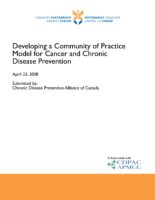
This project sought to develop recommendations for the design and implementation of a Community of Practice (CoP) model to support shared priorities for cancer and chronic disease prevention. It was developed from on a high level pragmatic review of selected literature pertaining to communities of practice, a web‐based survey designed to assess structural and functional elements and overall interest from potential community members, and a set of key informant interviews held with stakeholders working in cancer and chronic disease prevention.





